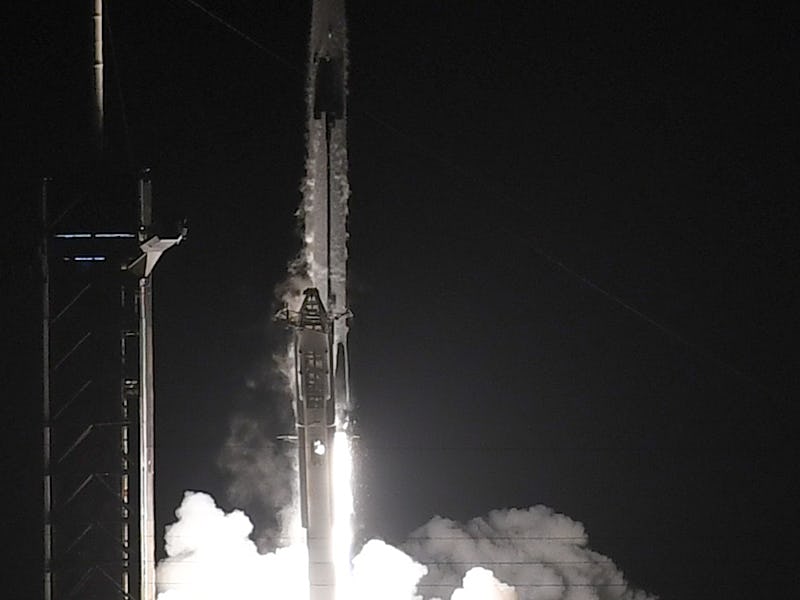SpaceX and NASA: A new era's arrival in 10 incredible pictures and videos
SpaceX and NASA just made history. Here's exactly how they did it.

Today's a big day for anyone who has ever clicked through a screen. The first human-computer interactions were possible due to a computer mouse, which was granted a patent on this day in 1970. Developed by Douglas Engelbart of the Stanford Research Institute, the mouse began a transformation from seeing computers as mere mathematical machines to things we can use in our everyday lives. He never got a dime for it, though, because the Stanford Research Institute didn't realize what they had. That's life!
Our question of the week is a big one for a lot of folks. How is Covid-19 affecting your plans for the holidays? It could be in big ways or small, but we'd love to hear about it. Shoot us an email at newsletter@inverse.com and let us know. We'll be publishing your responses!
And now, on with Inverse Daily...
This is an adapted version of the Inverse Daily newsletter for November 17, 2020. Subscribe for free and earn rewards for reading every day in your inbox.
94.5 — Moderna vaccine: 3 key details forecast a brighter future
On Monday, the drugmaker Moderna announced the results of a large-scale human trial evaluating the company’s coronavirus vaccine. It’s good news amid case counts hitting a record high: Interim results show that the vaccine was 94.5 percent effective in preventing Covid-19.
That number puts it in league with the Pfizer vaccine, which claimed to be 90 percent effective in preventing infection. It's another signal that there is a light at the end of this pandemic tunnel.
More like this:
Hidden gems — Zircon crystals found in Martian meteorite could unlock its volcanic past
In 2011, a piece of Mars was discovered in the Sahara desert. The shiny black stone weighing around 11 ounces was dubbed Northwest Africa 7533. Hidden in its inky depths, it contains clues to the Red Planet's origins.
The meteorite is believed to be one of the oldest discovered on Earth, and it could unlock the mysteries of Mars' past. Now, a team of scientists says they have discovered zircon crystals in the rock — clues to the history of Mars' volcanic activity.
The history of Mars is already on Earth →
More like this:
Wild thing — Humans are trying everything to make the wild livable for animals
The world’s natural spaces are in crisis. According to the United Nations, from 2015 through 2020 the rate of deforestation was estimated at 10 million hectares (38,610 square miles) per year. That amounts to a little over 193,000 square miles of forest destroyed in five years, larger than the entire state of California.
A new study out of China, published October 15 in Scientific Reports, details how scientists want to help solve the problem that humanity has created. Starting in 2015, the team built a series of artificial canopy bridges meant to reconnect newly disfigured and fragmented forests for gibbon monkeys who lived in the area.
While not perfect, the team found that their bridges were a “useful short-term solution” for helping animals in the wild while humanity gets its act together to begin reforestation. And they’re not the only ones.
Are salmon cannons and rope bridges the future? →
More like this:
Coming soon ...
Humans and plants have been inseparable ever since our species realized the incredible healing properties of the natural world. This week on Inverse, get ready for the latest intersection between flora and fauna: 3D bioprinting.
Solar geo-no-no — Futuristic climate solution could spell disaster for Earth's own defenses
Among other hard lessons, 2020 shows that climate change's deadly effects are no longer just a terrifying future — they are happening now.
Fires, floods, and drastic climatic swings are affecting people and animals across the world, and even our most desperate solutions might not save us. Rather, it could destroy one of our greatest natural protections.
But that doesn't mean we should throw in the towel just yet. A new study suggests that one of the most-debated future-proofing ideas, solar geoengineering, may not be the solution to our present crisis. But that doesn't mean it can't still play a crucial role in solving our planet's climate problem.
"Solar geoengineering is still feasible" →
More like this:
Blast off — SpaceX Crew Dragon: 10 stunning images and videos show the historic launch
The Crew Dragon has done it again.
SpaceX's human-carrying capsule, designed to help NASA send astronauts to and from the International Space Station, successfully launched with four astronauts Sunday evening. The "Crew-1" mission, the first non-test crewed mission for the capsule, lifted off at 7:27 p.m. Eastern from Launch Complex 39A at the Kennedy Space Center in Florida.
Here's what comes next for the Crew Dragon and its crew →
More like this:
- SpaceX Crew Dragon: video unveils incredible spacesuit
- SpaceX Crew Dragon: Elon Musk decries "stranger than fiction" problem
And that's it for the Daily! If you're looking for more, check out the most underrated apocalypse movie on Netflix...before it's too late.
Thank you for reading! Follow me on Twitter if you want, where I tweet too much.